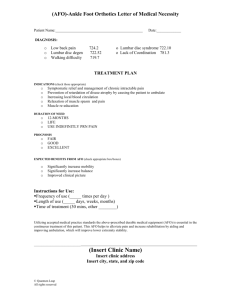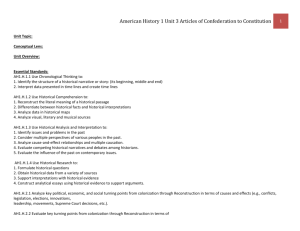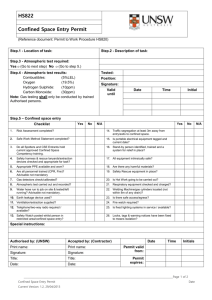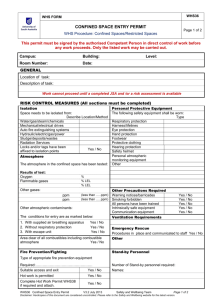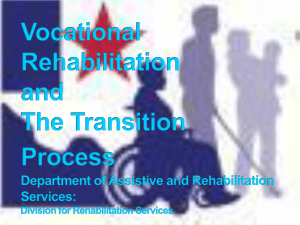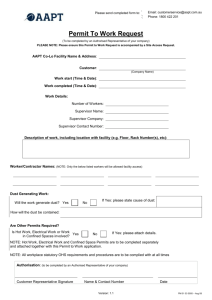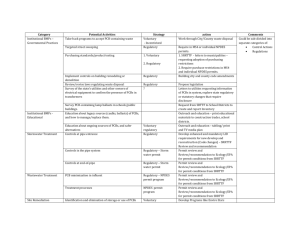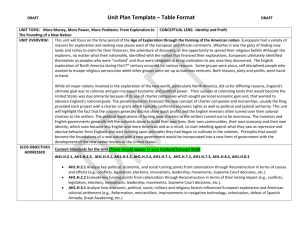CAFO Fact Sheet #14 - Heartland Regional Water Coordination
advertisement
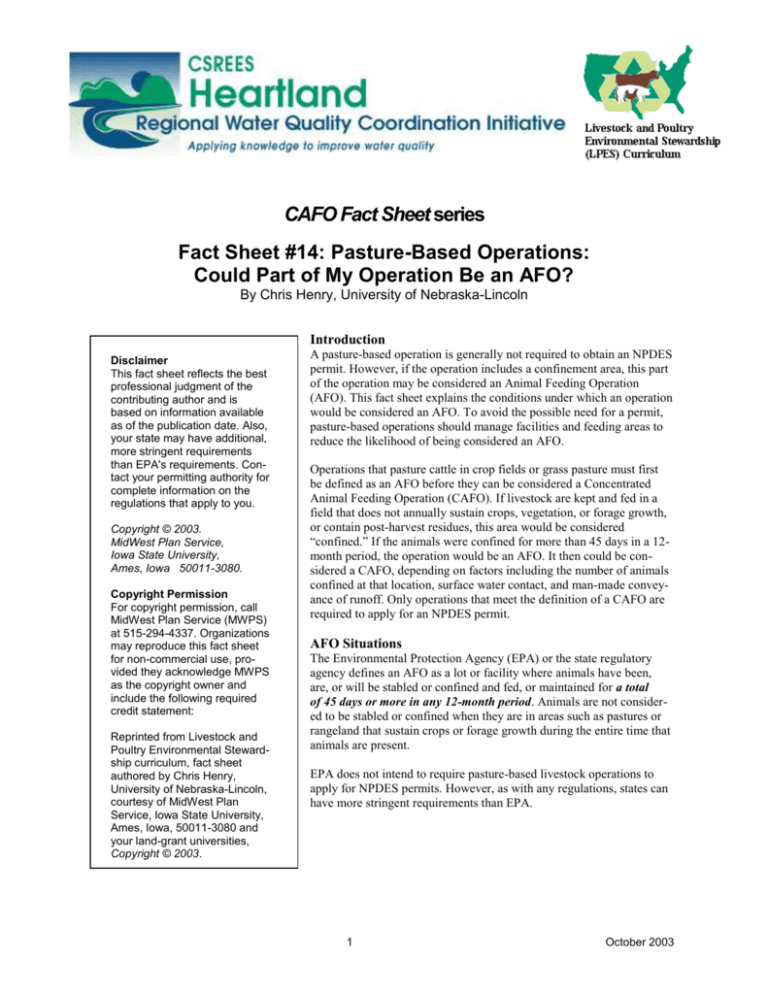
CAFO Fact Sheet series Fact Sheet #14: Pasture-Based Operations: Could Part of My Operation Be an AFO? By Chris Henry, University of Nebraska-Lincoln Introduction Disclaimer This fact sheet reflects the best professional judgment of the contributing author and is based on information available as of the publication date. Also, your state may have additional, more stringent requirements than EPA's requirements. Contact your permitting authority for complete information on the regulations that apply to you. Copyright © 2003. MidWest Plan Service, Iowa State University, Ames, Iowa 50011-3080. Copyright Permission For copyright permission, call MidWest Plan Service (MWPS) at 515-294-4337. Organizations may reproduce this fact sheet for non-commercial use, provided they acknowledge MWPS as the copyright owner and include the following required credit statement: Reprinted from Livestock and Poultry Environmental Stewardship curriculum, fact sheet authored by Chris Henry, University of Nebraska-Lincoln, courtesy of MidWest Plan Service, Iowa State University, Ames, Iowa, 50011-3080 and your land-grant universities, Copyright © 2003. A pasture-based operation is generally not required to obtain an NPDES permit. However, if the operation includes a confinement area, this part of the operation may be considered an Animal Feeding Operation (AFO). This fact sheet explains the conditions under which an operation would be considered an AFO. To avoid the possible need for a permit, pasture-based operations should manage facilities and feeding areas to reduce the likelihood of being considered an AFO. Operations that pasture cattle in crop fields or grass pasture must first be defined as an AFO before they can be considered a Concentrated Animal Feeding Operation (CAFO). If livestock are kept and fed in a field that does not annually sustain crops, vegetation, or forage growth, or contain post-harvest residues, this area would be considered “confined.” If the animals were confined for more than 45 days in a 12month period, the operation would be an AFO. It then could be considered a CAFO, depending on factors including the number of animals confined at that location, surface water contact, and man-made conveyance of runoff. Only operations that meet the definition of a CAFO are required to apply for an NPDES permit. AFO Situations The Environmental Protection Agency (EPA) or the state regulatory agency defines an AFO as a lot or facility where animals have been, are, or will be stabled or confined and fed, or maintained for a total of 45 days or more in any 12-month period. Animals are not considered to be stabled or confined when they are in areas such as pastures or rangeland that sustain crops or forage growth during the entire time that animals are present. EPA does not intend to require pasture-based livestock operations to apply for NPDES permits. However, as with any regulations, states can have more stringent requirements than EPA. 1 October 2003 A pasture-based operation, where animals wander freely to and from areas for food and shelter, is not considered an AFO. However, some pasture- and grazing -based operations may have confinement areas that qualify as an AFO. Incidental vegetation, such as weeds, in a clear area of confinement, such as a feedlot or pen, would not exclude an operation from meeting the definition of an AFO. In the case of a winter-feeding situation, the “no vegetation” criteria in the AFO definition is to be evaluated during the winter. Therefore, use of a winter feeding area to grow crops or other vegetation during periods of the year when animals are not present would not exclude the area from meeting the definition of an AFO, if animals are confined in the area for more than 45 days in a 12-month period. Conversely, a feeding area in a pasture that does not confine the animals (i.e., gate is open) and allows free access to rangeland or pasture would not qualify as a confined feeding area and would not be considered an AFO, regardless of the surface condition of the lot. Assessing Your Operation Use the following decision process to identify if your pasture or grazing operation could require a permit. This decision process is shown graphically on page 3. Step 1. Is any field where animals spend time devoid of vegetation? If the field is not cropped or maintains vegetation, this area may be considered a confined feeding area. Step 2. Are animals confined for more than 45 days during any 12-month period? If livestock are not kept in the confined area for more than 45 days, they would not be considered an AFO. Confinement of more than 45 days would define the operation as an AFO. For the purposes of this determination, any part of a day counts as a whole day. How to Avoid Being an AFO To avoid meeting the definition of an AFO, you will need to manage facilities so that they are considered pasture-based operations. This management may require keeping things mobile, such as hospital facilities, working chutes and penning, and feeding facilities or utilizing these areas for less than 45 days during any 12-month period. Do not allow animals to destroy the vegetation in an area that could be considered a confinement. 2 Tips to Avoid Becoming an AFO Do Keep gates open and allow free access to pastures and rangeland. Do not Confine animals for more than 45 days in a 12-month period. Allow animals to completely destroy vegetation in a lot or confined area that could be considered a confinement. Summary To avoid the potential requirement for an NPDES permit, pasture-based livestock producers should manage their operations so that they will not meet the definition of an AFO. This may require taking a different approach, than in the past, to managing confined feeding areas on cropland, pastures, and rangeland and limiting the amount of time that livestock spend in confined areas. Mitigating impact to surface waters and maintaining vegetation in confined areas is key to being excluded from the CAFO regulations. Definition of Terms AFO–Animal Feeding Operation. This can be either livestock or poultry. CAFO–Concentrated Animal Feeding Operation. An AFO that meets the definition of a CAFO must apply for an NPDES permit. EPA–Environmental Protection Agency. NPDES–National Pollutant Discharge Elimination System. The permit program that regulates CAFOs. State Permitting Authority–In many states, the state regulatory agency has the authority to administer federal permit programs such as the NPDES permit. State (or Species)-Specific Information (To be added by individual states or organizations) October 2003 Start here… Does the animal confinement area, or any area where animals access feed or shelter, sustain crops or forage growth during the growing season? YES NO Do these crop, grass, or forage residues remain during the winter months? NO YES Not an AFO, no NPDES Permit is required. Are animals confined in the area for more than 45 days in a 12month period? NO YES Operation is an AFO. If it also meets the definition of a CAFO, an NPDES Permit may be required. See Fact Sheet #2: Do I Need an NPDES Permit for My Livestock or Poultry Operation? Authors Chris Henry, an Extension Engineer at the University of Nebraska-Lincoln, can be reached at chenry1@unl.edu. Reviewers The author wishes to thank Ralph Summers, EPA Region 7; Gary Buttermore and Alan Rosenboom, Nebraska Department of Environmental Quality; and Claudia Elkins, Kansas Department of Health and Environment, for their review of this fact sheet. 3 October 2003 For More Information State Contacts EPA CAFO Phone Line Nebraska Iowa Missouri National and Regional 202-564-0766 202-564-0766 202-564-0766 202-564-0766 http://www.oznet.ksu.edu/ kcare/ http://extension.agron.iastate .edu/immag/ http://outreach.missouri.edu/mo mmag/ http://www.epa.gov/npdes /caforule/–To obtain copy of regulations Gary Buttermore John Harsch Gene Tinker Randy Kixmiller Ralph Summers (402)-471-4255 (785) 296-0075 (515) 281-3103 (573) 751-6568 (913) 551-7418 gary.Buttermore@ndeq.state.ne.us jharsch@kdhe.state.ks.us gene.tinker@dnr.state.ia.us nrkixmr@dnr.state.mo.us summers.ralph@epa.gov Rick Koelsch Joel DeRouchey John Lawrence John Lory State Cooperative Extension contacts 402-472-4051 (785) 532-2280 (515) 294-6290 (573) 884-7815 rkoelsch1@unl.edu jderouch@oznet.ksu.edu jdlaw@iastate.edu LoryJ@missouri.edu Mike Kucera Lyle Frees Chris Murray Troy Chockley (402) 471-4102 (785) 823-4553 (515) 284-4370 573-876-9394 Michael.Kucera@ne.usda.gov lyle.frees@ks.usda.gov chris.murray@ia.usda.gov troy.chockley@mo.usda.gov Educational Resources http://www.lpes/ http://www.lpes/ http://www.lpes/ http://www.lpes/ http://www.lpes/ USDA Farm Bill Resources http://farmbill.unl.edu/ See national site See national site See national site http://www.nrcs.usda.gov/ programs/farmbill/2002/ Environmental Regulations Related Resources State Environmental Regulatory Agency State Cooperative Extension State Natural Resources Conservation Service (NRCS) 202-564-0766 Kansas http://manure.edu.edu http://cnmp.unl.edu The LPES educational materials were developed with support from the USDA-CSREES, the U.S. EPA’s National Agriculture Compliance Assistance Center, and the University of Nebraska Cooperative Extension at Lincoln, under Cooperative Agreement Number 97-EXCA-3-0642. 4 http://www.reeusda.gov/1 700/statepartners/usa.htm/ MWPS (MidWest Plan Service), headquartered at Iowa State University, is the primary distributor of LPES curriculum materials. To order the materials on-line, access their website at http://www.mwpshq.org and visit the catalog section. Discounts are offered on LPES materials. October 2003
